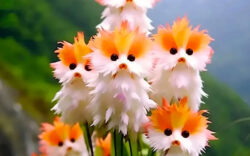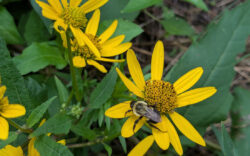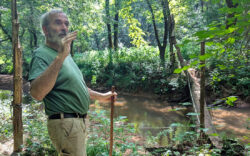Whether foraged or bought, plastic duplicate or messy original, bringing plants into our homes is a holiday staple. I am a fan of the real thing, but allergies, small children and nibbling pets are limiting factors for some. If you’re interested in expanding your natural holiday decor, here are a few tips for finding and using plants around the house:
Poinsettias: The big bright red things that look like petals? Not actually petals! It’s a bract, or a modified leaf. The center of a healthy poinsettia should contain little yellow and green nodules—these are the petalless flowers (technically named cyathia). Choose a plant where the stamens (male reproductive part of a flower) are just starting to poke out. Avoid plants where the cyathia have fallen off. Once the flowers are gone, the beautiful bracts fall off soon after.
Most poinsettias come in a foil or plastic pot cover. Get rid of it. The cover can retain too much moisture and kill your plant prematurely. Poinsettias, native to Mexico, dislike big fluctuations in temperature and anything colder than 50 degrees Fahrenheit. It’s best to place them somewhere in your home away from heating ducts or cold window panes. Instead, opt for a table or counter where the plant can receive some light.
Poinsettia’s reputation as poisonous can be overblown as it’s not deadly. Some people do get a rash when handling the plant’s sap, and eating the leaves can cause an upset stomach. As long as you don’t have a severe allergy to it, a poinsettia shouldn’t have lasting or lethal effects.
Poinsettias are symbols of Christmas because of smart marketing. A Southern California family of farmers named Ecke bred poinsettias to keep their red-and-green holiday colors for a few weeks instead of a few days. To drum up demand, the farm supplied free poinsettias for magazine holiday spreads and television Christmas specials hosted by Bob Hope and Johnny Carson. The marketing worked as more and more shoppers chose to bring home a potted poinsettia.
Mistletoe: It doesn’t smell great like Frasier firs, nor is it showy, like a poinsettia. Instead, bundle and hang the humble mistletoe over doorways to start impromptu smooch sessions during the holidays. This tradition started with a Christmas game servants in Victorian England played for stealing kisses. People threw away the rules during the next century, but kept the canoodling.
Mistletoe is a parasitic plant, feeding off the nutrients and water of its host. Though mistletoe is a leech, and capable of killing a tree eventually, it is a needed food source for wild critters. For example, caterpillars of the iridescent native Great Purple Hairstreak butterfly munch on the plant. If you go foraging for it, be sure to leave some for the wildlife.
Mistletoe prefers hardwoods. I’ve found it in trees planted in parking lots and near sidewalks. The plant’s bright green or yellow leaves are a marked contrast to the bare limbs of its host. The plant is brittle, and a few stems can be wacked off with a stick. Don’t take mistletoe from a state or federal park; it’s illegal. Don’t take plant material from a private garden or property without asking; your neighbors won’t like it.
Mistletoe is poisonous in much the same way poinsettias are. Eating the leaves and berries can result in vomiting and diarrhea. Effects will be worse for a pet or small child than an adult, but shouldn’t be lethal. Still, if you’ve got a small person or animal who likes to taste everything around them, a plastic version might be a safer bet.
Holly: From “Deck the Halls” to “The Holly and the Ivy,” holly is such a Christmas decorating standard it’s got its own tunes. Holly has long been a symbol of winter, Christmas and protection.
Holly is often used as a landscaping plant, sometimes added around the foundation of a home, or to provide privacy. If you don’t have a bush in your yard, you likely have a neighbor willing to share some of their bounty. While holly wreaths are possible, they can be painful to construct. I suggest sticking small twigs into a pre-constructed wreath (those made with cedar, Leyland Cypress or Fraser firs are my favorites). Other options include arranging holly in a vase or along a mantle.
Holly, too, is poisonous (but usually not lethal) if eaten. If anyone at your home eats any of these plants, or something else, you can call the Georgia Poison Hotline at 1-800-222-1222 for humans and the Animal Poison Control Center at 1-888-426-4435 for pets.
Like what you just read? Support Flagpole by making a donation today. Every dollar you give helps fund our ongoing mission to provide Athens with quality, independent journalism.










